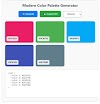🚀 Machine Learning Roadmap for Students in 2025
Want to learn Machine Learning in 2025? Whether you're a complete beginner or a curious computer science student, this roadmap is your step-by-step guide to mastering Machine Learning (ML) from scratch.
🎯 What is This Roadmap About?
This machine learning roadmap is built for students who want to:
- Start a career in AI or Data Science
- Understand real-world ML applications
- Build projects and a strong portfolio
✅ Step-by-Step Machine Learning Roadmap for Students
📘 Step 1: Learn Python Programming
Start with the basics of Python, the most used language in ML.
- Variables, loops, functions, and OOP
- Practice with Jupyter Notebook or Google Colab
📊 Step 2: Study Math for Machine Learning
Focus on core areas like:
- Linear Algebra: Vectors, Matrices
- Statistics: Probability, Distributions
- Calculus: Derivatives, Optimization
📊 Step 3: Learn Data Analysis & Visualization
- Libraries: NumPy, Pandas, Matplotlib, Seaborn
- Do Exploratory Data Analysis (EDA) on real datasets
🤖 Step 4: Understand Machine Learning Concepts
- What is ML?
- Types: Supervised, Unsupervised, Reinforcement Learning
- ML workflow: data ➝ model ➝ evaluation ➝ deployment
🧠 Step 5: Supervised Learning Algorithms
- Linear & Logistic Regression
- k-Nearest Neighbors (kNN), SVM
- Decision Trees, Random Forests
🔍 Step 6: Unsupervised Learning Techniques
- Clustering: K-Means, DBSCAN
- PCA, t-SNE for dimensionality reduction
📏 Step 7: Model Evaluation & Tuning
- Train/test split, cross-validation
- Metrics: accuracy, precision, recall, F1, ROC-AUC
- Hyperparameter tuning: GridSearchCV
🧩 Step 8: Work with Real Datasets
Use platforms like:
💡 Step 9: Build Mini Projects
- Spam email detector
- Movie recommendation system
- MNIST digit classifier
🧠 Step 10: Learn Deep Learning Basics
- Neural networks: Perceptrons, MLPs
- CNNs (images), RNNs (sequences)
- Tools: TensorFlow, Keras
🚀 Step 11: Deploy Your ML Models
- Use Flask or FastAPI to build ML APIs
- Dockerize your project
- Create dashboards with Streamlit
🎓 Step 12: Build Your Portfolio
Showcase your ML work online:
- Push all projects to GitHub
- Write blog posts or LinkedIn articles
- Create a personal portfolio website
🧠 Final Tips for Students Learning ML
- Be consistent — code every day
- Join ML communities on Discord, Reddit, and GitHub
- Follow updates from OpenAI, DeepMind, HuggingFace, etc.







0 Comments